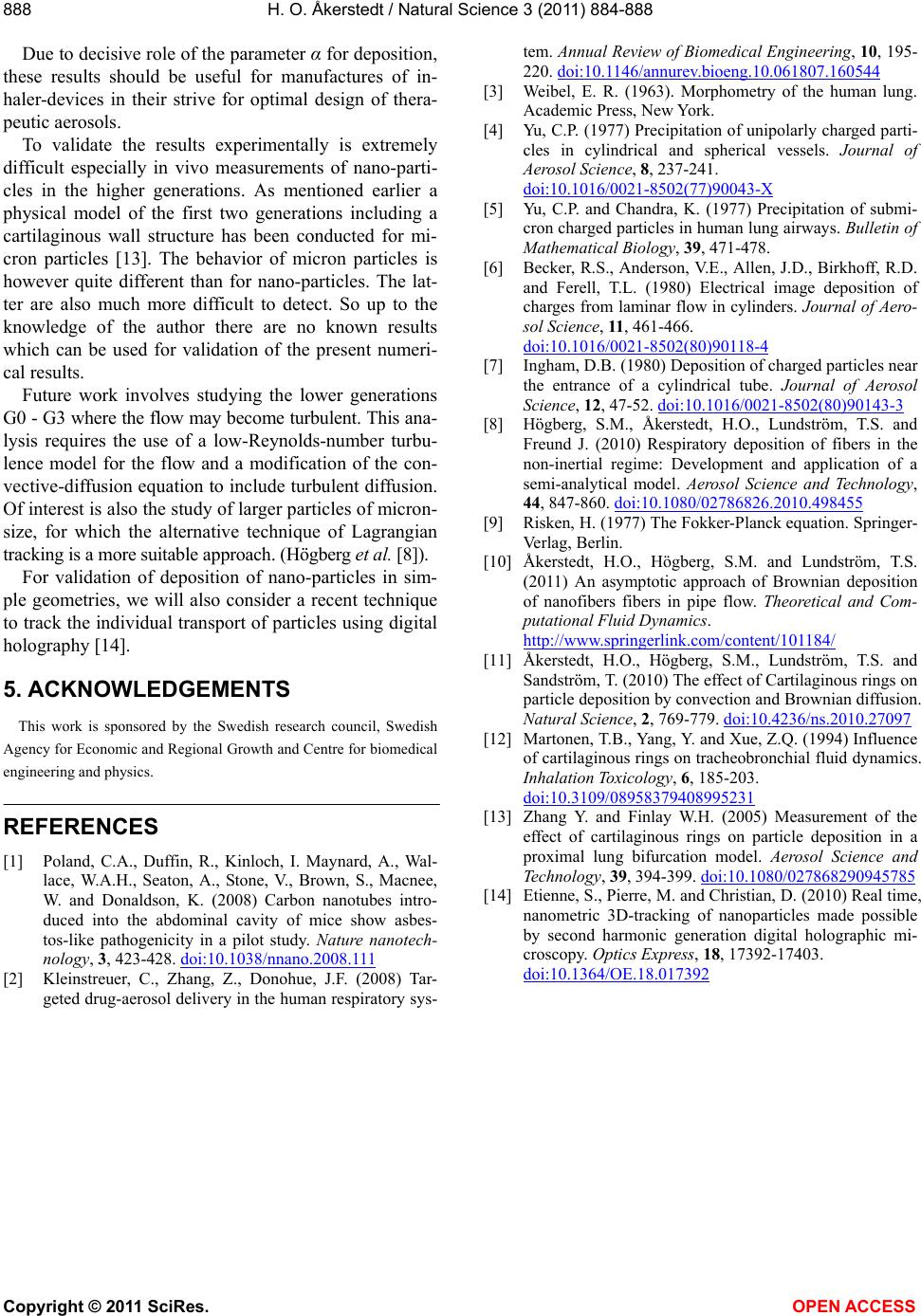
H. O. Åkerstedt / Natural Science 3 (2011) 884-888
Copyright © 2011 SciRes. OPEN ACCESS
888
Due to decisive role of the parameter α for deposition,
these results should be useful for manufactures of in-
haler-devices in their strive for optimal design of thera-
peutic aerosols.
To validate the results experimentally is extremely
difficult especially in vivo measurements of nano-parti-
cles in the higher generations. As mentioned earlier a
physical model of the first two generations including a
cartilaginous wall structure has been conducted for mi-
cron particles [13]. The behavior of micron particles is
however quite different than for nano-particles. The lat-
ter are also much more difficult to detect. So up to the
knowledge of the author there are no known results
which can be used for validation of the present numeri-
cal results.
Future work involves studying the lower generations
G0 - G3 where the flow may become turbulent. This ana-
lysis requires the use of a low-Reynolds-number turbu-
lence model for the flow and a modification of the con-
vective-diffusion equation to include turbulent diffusion.
Of interest is also the study of larger particles of micron-
size, for which the alternative technique of Lagrangian
tracking is a more suitable approach. (Högberg et al. [8]).
For validation of deposition of nano-particles in sim-
ple geometries, we will also consider a recent technique
to track the individual transport of particles using digital
holography [14].
5. ACKNOWLEDGEMENTS
This work is sponsored by the Swedish research council, Swedish
Agency for Economic and Regional Growth and Centre for biomedical
engineering and physics.
REFERENCES
[1] Poland, C.A., Duffin, R., Kinloch, I. Maynard, A., Wal-
lace, W.A.H., Seaton, A., Stone, V., Brown, S., Macnee,
W. and Donaldson, K. (2008) Carbon nanotubes intro-
duced into the abdominal cavity of mice show asbes-
tos-like pathogenicity in a pilot study. Nature nanotech-
nology, 3, 423-428. doi:10.1038/nnano.2008.111
[2] Kleinstreuer, C., Zhang, Z., Donohue, J.F. (2008) Tar-
geted drug-aerosol delivery in the human respiratory sys-
tem. Annual Review of Biomedical Engineering, 10, 195-
220. doi:10.1146/annurev.bioeng.10.061807.160544
[3] Weibel, E. R. (1963). Morphometry of the human lung.
Academic Press, New York.
[4] Yu, C.P. (1977) Precipitation of unipolarly charged parti-
cles in cylindrical and spherical vessels. Journal of
Aerosol Science, 8, 237-241.
doi:10.1016/0021-8502(77)90043-X
[5] Yu, C.P. and Chandra, K. (1977) Precipitation of submi-
cron charged particles in human lung airways. Bulletin of
Mathematical Biology, 39, 471-478.
[6] Becker, R.S., Anderson, V.E., Allen, J.D., Birkhoff, R.D.
and Ferell, T.L. (1980) Electrical image deposition of
charges from laminar flow in cylinders. Journal of Aero-
sol Science, 11 , 461-466.
doi:10.1016/0021-8502(80)90118-4
[7] Ingham, D.B. (1980) Deposition of charged particles near
the entrance of a cylindrical tube. Journal of Aerosol
Science, 12, 47-52. doi:10.1016/0021-8502(80)90143-3
[8] Högberg, S.M., Åkerstedt, H.O., Lundström, T.S. and
Freund J. (2010) Respiratory deposition of fibers in the
non-inertial regime: Development and application of a
semi-analytical model. Aerosol Science and Technology,
44, 847-860. doi:10.1080/02786826.2010.498455
[9] Risken, H. (1977) The Fokker-Planck equation. Springer-
Verlag, Berlin.
[10] Åkerstedt, H.O., Högberg, S.M. and Lundström, T.S.
(2011) An asymptotic approach of Brownian deposition
of nanofibers fibers in pipe flow. Theoretical and Com-
putational Fluid Dynamics.
http://www.springerlink.com/content/101184/
[11] Åkerstedt, H.O., Högberg, S.M., Lundström, T.S. and
Sandström, T. (2010) The effect of Cartilaginous rings on
particle deposition by convection and Brownian diffusion.
Natural Science, 2, 769-779. doi:10.4236/ns.2010.27097
[12] Martonen, T.B., Yang, Y. and Xue, Z.Q. (1994) Influence
of cartilaginous rings on tracheobronchial fluid dynamics.
Inhalation Toxicology, 6, 185-203.
doi:10.3109/08958379408995231
[13] Zhang Y. and Finlay W.H. (2005) Measurement of the
effect of cartilaginous rings on particle deposition in a
proximal lung bifurcation model. Aerosol Science and
Technology, 39, 394-399. doi:10.1080/027868290945785
[14] Etienne, S., Pierre, M. and Christian, D. (2010) Real time,
nanometric 3D-tracking of nanoparticles made possible
by second harmonic generation digital holographic mi-
croscopy. Optics Express, 18, 17392-17403.
doi:10.1364/OE.18.017392